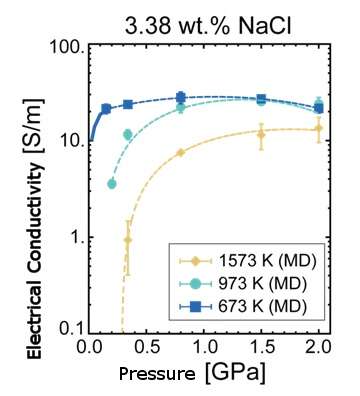A step forward in understanding mechanisms behind magma generation and the outbreak of earthquakes

A joint research team consisting of Hiroshi Sakuma, senior researcher, Functional Geomaterials Group, Environment and Energy Materials Division, National Institute for Materials Science (NIMS), Japan, and Masahiro Ichiki, assistant professor, Graduate School of Science, Tohoku University, Japan, succeeded in theoretically determining the electrical conductivity of NaCl solution (salt water) in a high-temperature and high-pressure environment at ground depths ranging from 10 to 70 km. By comparison with electrical conductivity data collected underground, the theoretical approach indicated the presence of salt water deep underground. This discovery may reinforce the theory that underground salt water influences the occurrence of earthquakes and volcanic eruptions.
It is commonly said that the presence of salt water in bedrock makes a fault prone to slide, influencing the occurrence of earthquakes, or decreases the melting points of rocks, influencing volcanic eruptions.
However, it is difficult to directly verify the presence of salt water through drilling surveys deep underground. Since liquids including salt water have electrical conductivity about six orders of magnitude higher than that of solids, surveys involving the measurement of electrical conductivity are often carried out to detect the presence of salt water. However, because the electrical conductivity of salt water under the high-temperature and high-pressure conditions occurring in such environments as crustal seismogenic zones is unknown, it had been impossible to associate electrical conductivity measurements with the presence of salt water.
The research team developed a molecular model to reproduce the supercritical state of water. Using the model, the team successfully calculated electrical conductivity of salt water with NaCl concentrations ranging from one-sixth to triple that in seawater at high temperature and high pressure (temperature: 673-2,000 K, pressure: 0.2-2 GPa), conditions that are difficult to simulate in experiments. These electrical conductivity data indicated that high electrical conductivity measured under the ground in the Tohoku region may be explained by the presence of salt water with salt concentrations equivalent to seawater.
In future studies, we will combine these results with the electromagnetic crustal observations across Japan to identify the presence of salt water deep underground where seismic and volcanic activities are high, as in subduction zones, and conduct research in order to understand the mechanism of the outbreak of earthquakes and volcanic eruption.
This research was conducted as a part of the projects "Geofluids: nature and dynamics of fluids in subduction zones," (Grant-in-Aid for Scientific Research on New Academic Related Areas) and "Research on understanding supercritical fluid properties in crust through molecular dynamics calculation and its influence on earthquake occurrence," (Grant-in-Aid for Challenging Exploratory Research) supported by the Ministry of Education, Culture, Sports, Science and Technology.
This research was published in the online version of Journal of Geophysical Research: Solid Earth, on January 20, 2016.
More information: Hiroshi Sakuma et al. Electrical conductivity of NaCl-HO fluid in the crust, Journal of Geophysical Research: Solid Earth (2016). DOI: 10.1002/2015JB012219
Provided by National Institute for Materials Science




















